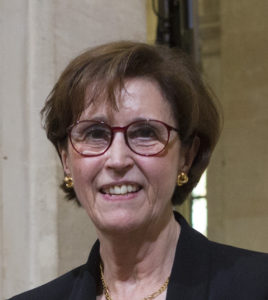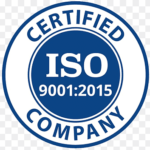Janine Cossy’s early career was spent in Reims, where she did her undergraduate and graduate studies at the University of Champagne-Ardenne, working on photochemistry under the supervision of Prof Jean Pierre Pete. After a postdoctoral stay with Prof Barry M. Trost, for two years at the University of Wisconsin (USA), she returned to Reims where she became, in 1990, Director of Research at the CNRS. In the same year, she moved to Paris and, since 1990, she is Professor of Organic Chemistry at the ESPCI Paris.
Janine Cossy’s research interests focus on the synthesis of natural products and biologically active molecules and on the development of synthetic methods (organometallic reactions, catalysis, ring expansions, opening of strained rings, methods for the synthesis of heterocyclic compounds, stereoselective reactions). She has many collaborations with pharma and agro companies. Her research efforts have resulted in more than 510 publications and 15 patents.

Among the awards, she received the CNRS Bronze Medal (France, 1987), the CNRS Silver Medal (France, 1996), UK Royal Society Rosalyn Franklin International Lecturership awarded to internationally recognized women scientists (UK, 2005), the Le Bel Award from the French Chemical Society (France, 2009). In 2013, she was nominated Chevalier de la Legion d’Honneur and in 2015, she obtained the E.C. Taylor Senior Award (USA) and the UR Ghatak endowment award (IACS, India), the Susan P. and Barry M. Trost Lecture in Organic Synthesis (USA, 2016), the Tarrant Professorship (USA, 2016), the Lu Jiaxi lecturership (China, 2017) and in 2017, she was elected at the French Academy of Sciences. In 2018, she received a Grant from the Bill & Melinda Gates Fundation (USA), was promoted Officier de l’Ordre National du Merite (France), nominated American Chemical Society Fellow (USA), and she also received the award of Professor PC RAY Chair from the Indian National Science Academy (INSA, India). In 2019, she was awarded IUPAC 2019 Distinguished Women in Chemistry or Chemical Engineering. It is worth pointing out that she was one of the Organic Letters Associate Editor from 2005 to 2018.
J. Cossy is well known for her work in the development of original methods and in the synthesis of complex natural and/or biologically active compounds using elegant and efficient strategies. It is worth mentioning that she has synthesized around 80 natural and non-natural products and around 30 complex fragments of natural products. Among the products that she has synthesized, ML 3000, an anti-inflammatory compound, went in Phase II of biological tests. The following aspects of her research are most noteworthy:
At the beginning of her career, Janine Cossy made important contributions in the area of radical chemistry, generating these species by electron-transfer induced by photochemistry, avoiding toxic metals (green chemistry). She has demonstrated the potential of these photochemically induced radicals in the synthesis of natural products and bioactive compounds (terpenes, alkaloids, lactones ). Recently,one reaction has been named in the literature (the Cossy photocyclization) (I. Ryu et al. Org. Lett. 2016, p 5444 ).
She has also made an important contribution in enantioselective rearrangements. Among them, an exceptional enantioselective rearrangement of optically active prolinols to produce C3-substituted piperidines in excellent enantiomeric excess was tuned up. The introduction of a great variety of substituents at the C3 position of substituted piperidines is of interest for the medicinal chemists and, for example, in collaboration with Merck-Serono, this type of rearrangement was used to synthesize a BKT inhibitor possessing a 3-fluoro-piperidine. Her group is also involved in the diasteroselective [2,3]-Wittig rearrangement to produce syn- and anti-amino-alcohols.
She made important contributions in the development of alkene cross-metathesis. she showed that the Grubbs-Hoveyda catalyst is a very chemoselective catalyst which is tolerant towards polar groups (alcohols, acids, acid chlorides, alkylidene lactones, vinyl heterocycles …). Highly functionalized olefins were produced and, many applications to complex natural products illustrate the power of the cross-metathesis. In addition, she has used the ring-closing metathesis to produce heterocycles and she was the first one to report the synthesis of cyclic hydroxamic ethers and cyclic allyl siloxanes.
An other contribution also deserves brief mentioning, as she is also recognized for the sunthesis of polyketides natural products. She has developed an enantio- and diastereoselective method by using the Duthaler’s TADDOL allyl- and crotyl-titanium reagents to produce syn- and anti-1,2- and 1,3-diols as well as polypropionates, demonstrating that these reagents were very chemo- and face selective. The use of these reagents, in combination with a cross-metathesis or a ring-closing metathesis, has allowed her to have an efficient access to complex molecules without any protection of polar groups such as alcohols or amines. A variety of bioactive comopounds such as migrastatin, leucascandrolide, cytostatine, fostreicine, the monomeric fragment of marinomycine, herbimycine, pseudotrienic acid B,. as been synthesized ) Since 2006-2007, J. Cossy is more and more recognized for her contribution in organometallic reactions, using palladium, gold, rhodium, iron and cobalt catalysts. With palladium catalysts, she was able to develop an enantioselective rearrangement of allyldienol carbonates producing a diversity of optically active substituted lactones as well as a diversity of furans and pyrroles. She has pionnering the use of gold catalyst for the cycloisomerization of ene-ynamines to produce heterocycles and, more recently, she showed that cyclopropenes can be good surrogates for diazoketones as, when they are treated either with gold catalysts or rhodium catalysts, metalla-carbenoids are produced and can insert in double bonds or C-H bonds, leading efficiently to heterocycles .
Cossy’s contributions to iron and cobalt catalysts must also be mentioned. The implications for the fine chemical synthesis are obvious if one can replace palladium catalysts by cheap iron or cobalt salts as cross-coupling catalysts, or use them to induce cyclizations. The efficient coupling of vinyl Grignard with functionalized alkyl halides in the presence of a simple iron salt (FeCl3), is a powerful cross-coupling method and has been applied to the synthesis of the spiroketal of spirangien A. In addition, she demonstrated that the reactivity of Grignard reagents can also be modified by cobalt salts. She demonstrated that chemo- and stereoselective coupling reactions, induced by simple cobalt salts, were demonstrated to be of importance to produce -C-glycosides (inhibitors of carbohydrate processing enzymes) from -bromo-glycosides and aryl-, heteroaryl- or vinyl-Grignard reagents. If the intermediates generated with the iron catalysts are not well established, she has demonstrated that a radical pathway was taking place in the cobalt-catalyzed coupling reactions. In addition to the coupling reactions, J. Cossy is using iron catalysts to induce very chemo- and stereo-selective cyclizations to produce heterocycles.
It is worth mentioning that J. Cossy has developed new perfluoronating agents “«RfCH=N2» from simple amines. This reagents allowed to introduce easily fluoro gropus on insaturated molecules and are of great interest for medicinal chemist. This recent work is highly cited.
Very recently, as J. Cossy is interested in the vectorisation of active compounds towards tumors, she is involved in a multidisciplinary project and, in association with physico-chemists and physicists, they have demonstrated that a high spatio-temporal control of spontaneous chemical reactions can take place using ultrasound composite droplets. This result shows that the vectorization of active compounds toward tumors should be possible. In addition, she is involved in the vectorization of antitumoral agents toward the bladder by using immunoconjugates constituted by a drug, a linker and only a antibody fragment.

